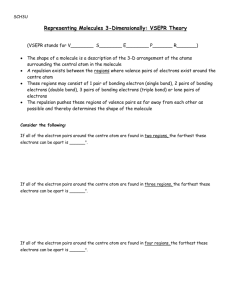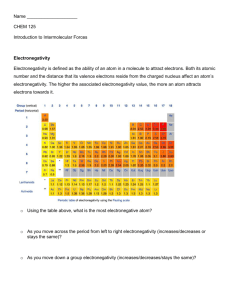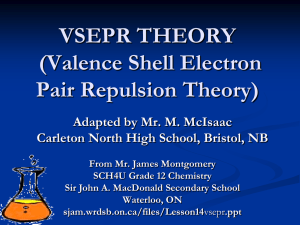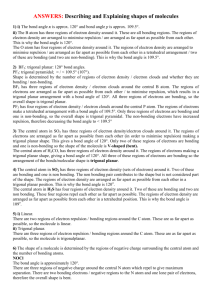71KB - NZQA
advertisement
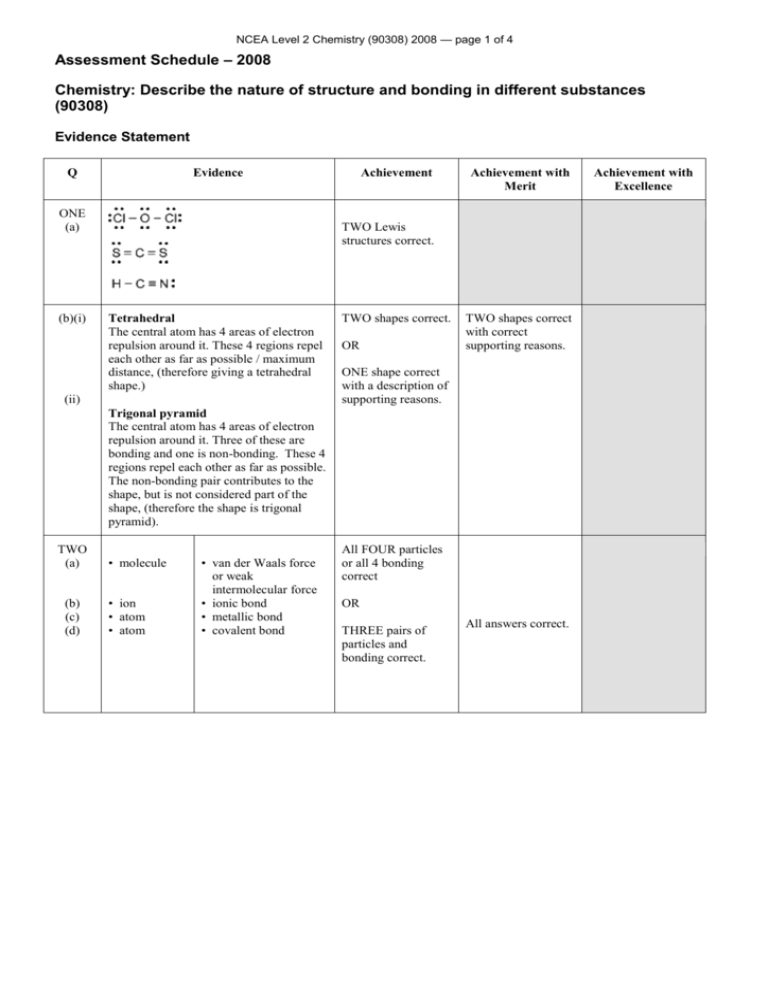
NCEA Level 2 Chemistry (90308) 2008 — page 1 of 4 Assessment Schedule – 2008 Chemistry: Describe the nature of structure and bonding in different substances (90308) Evidence Statement Q Evidence ONE (a) (b)(i) Achievement Achievement with Merit TWO Lewis structures correct. Tetrahedral The central atom has 4 areas of electron repulsion around it. These 4 regions repel each other as far as possible / maximum distance, (therefore giving a tetrahedral shape.) (ii) TWO shapes correct. OR TWO shapes correct with correct supporting reasons. ONE shape correct with a description of supporting reasons. Trigonal pyramid The central atom has 4 areas of electron repulsion around it. Three of these are bonding and one is non-bonding. These 4 regions repel each other as far as possible. The non-bonding pair contributes to the shape, but is not considered part of the shape, (therefore the shape is trigonal pyramid). TWO (a) (b) (c) (d) • molecule • ion • atom • atom • van der Waals force or weak intermolecular force • ionic bond • metallic bond • covalent bond All FOUR particles or all 4 bonding correct OR THREE pairs of particles and bonding correct. All answers correct. Achievement with Excellence NCEA Level 2 Chemistry (90308) 2008 — page 2 of 4 THREE (a) Lewis structures of XO2 and YO2 correct Lewis structures for BOTH molecules correct 1 Lewis diagram and its bond angle Lewis structures for both molecules correct, and shape or bond angle or explanation of repulsion correctly derived for ONE molecule OR OR correct bond angles based on incorrect Lewis Diagrams. Shapes (linear for XO2; trigonal planar arrangement of electron clouds / bent shape / 3 electron areas for YO2) and bond angles derived correctly for BOTH molecules. OR (b) XO2 has 2 areas of electron repulsion / regions of electrons / negative centres about the central atom. This leads to a bond angle of linear shape, which has a bond angle of 180°. YO2 has three areas of electron repulsion / regions of electrons / negative centres about the central atom. This leads to a trigonal planar arrangement of electron clouds / bent shape, which has a bond angle of 120°. Lewis structures, shapes (linear for XO2; trigonal planar arrangement of electron clouds / 3 electron areas for YO2) and bond angles derived correctly for BOTH molecules. NCEA Level 2 Chemistry (90308) 2008 — page 3 of 4 FOUR NH3 polar molecule The molecule has 4 areas of electron repulsion around the central N atom (3 bonding and one non-bonding), so the shape is trigonal pyramid. The N–H bond is polar, due to the difference in electronegativity of N and H. As these polar bonds are asymmetrical about the N atom in NH3, the effect of them is not cancelled, so the molecule is polar. COCl2 polar molecule The molecule has 3 areas of electron repulsion around the central C atom, so the shape is trigonal planar. Polarities correct for both molecules with ONE supporting reason for each. OR BOTH polarities correct and differing polarity of bonds recognised with justification of polarity that is related to shape or symmetry or electronegativity. Full discussion for BOTH molecules that includes concept of electronegativity differences and acknowledges shape and symmetry. Achieved PLUS Conductivity for the two substances is correctly and clearly discussed with reference to structure and bonding (including copper chloride as both aqueous and molten). Description of polarity of bonds in ONE molecule and a description that the polarity of a molecule involves a combination of shape, symmetry, electronegativity. Both C–Cl bonds are polar, due to the difference in electronegativity of C and Cl. The C=O bond is also polar, due to the difference in electronegativity of C and O. Even though the shape is trigonal planar, the molecule is asymmetrical, as the electronegativity difference of the three bonds is not the same. Therefore the effects of these polar bonds are not cancelled and the molecule is polar overall. FIVE Substances ONE and TWO are graphite and copper chloride. In graphite (solid) each carbon atom is covalently bonded to 3 others. (This leaves one electron that is) delocalised and is free to move. Because this electron is free to move, it carries charge and so graphite conducts electricity. Copper chloride (solid) consists of a 3–D lattice of Cu2+ and Cl– ions. Although charged particles are present, they are held in position by strong ionic bonds, and the solid does not conduct electricity. When the CuCl2 solid is melted, the ions become free moving, and the free moving ions means the liquid can conduct electricity. When CuCl2 is dissolved in water the ions are then free to move because the ions are no longer held in the lattice. Because of this, the solution can conduct electricity. Graphite’s conductivity is due to delocalised / free moving electrons AND CuCl2’s conductivity will be due to ions. Bonding of BOTH substances is identified, CuCl2 ionic bonding, graphite covalently bonded, plus the conductivity of ONE is explained in terms of EITHER delocalised / free moving electrons (in graphite) OR mobile ions (in molten CuCl2 or an aqueous solution of CuCl2). NCEA Level 2 Chemistry (90308) 2008 — page 4 of 4 SIX Zinc consists of Zn atoms held together in a 3–D lattice by metallic bonding, in which valence electrons are attracted to the nuclei of neighbouring atoms. The attraction of the zinc atoms for the valence electrons is not in any particular direction, so therefore zinc atoms can move past one another, and so zinc is malleable. Zinc is not soluble in water, as the metallic bonds are too strong to be broken by the attraction to the water molecules. Zinc chloride consists of a regular array of zinc and chloride ions held together by ionic bonds in a lattice. The bonds within ZnCl2 are directional so ZnCl2 is not malleable. ZnCl2 will dissolve in water as water is polar and the partial charges on water are attracted to the oppositely charged ion. (This attraction is sufficient to pull the ions from the lattice.) Correctly identifies a property for ONE of the substances, ie: Zn is malleable and insoluble OR ONE property (of malleability or solubility in water), compared with reference to structure and bonding for BOTH solids. TWO properties compared (of malleability and solubility in water), with reference to structure and bonding for BOTH solids. ZnCl2 is not malleable and dissolves in water. Judgement Statement Achievement Achievement with Merit Achievement with Excellence Total of FOUR opportunities answered at Achievement level or higher. Total of at least FOUR opportunities answered with THREE at Merit level or higher. Total of at least FIVE opportunities answered with TWO at Excellence level and TWO at Merit level or higher. 4A 3M + 1A 2E + 2M + 1A






